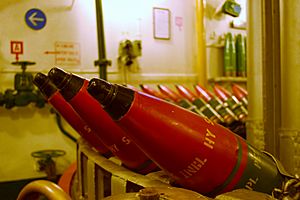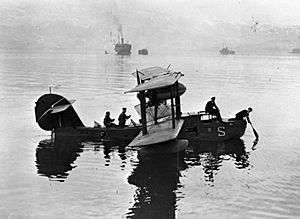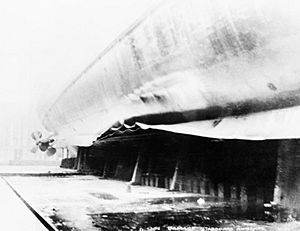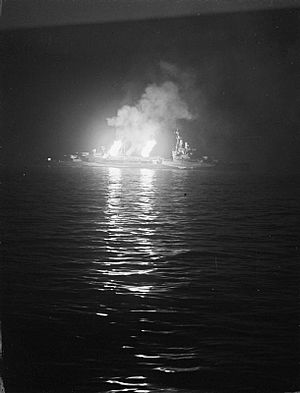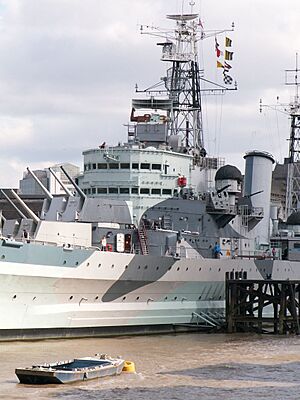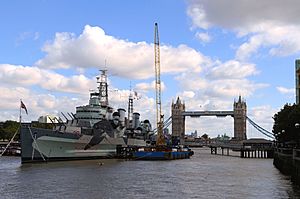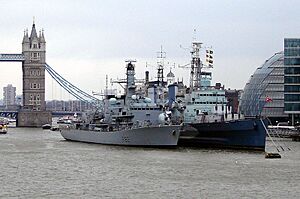HMS Belfast facts for kids
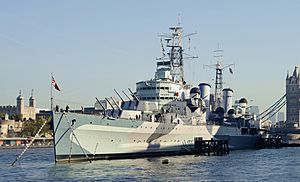
HMS Belfast at her London berth, painted in Admiralty pattern Disruptive Camouflage
|
|
Quick facts for kids History |
|
|---|---|
| Name | Belfast |
| Namesake | Belfast, Northern Ireland |
| Ordered | 21 September 1936 |
| Builder | Harland and Wolff shipyard, Belfast, Northern Ireland |
| Yard number | 1000 |
| Laid down | 10 December 1936 |
| Launched | 17 March 1938 |
| Completed | 3 August 1939 |
| Commissioned | 5 August 1939 |
| Decommissioned | 24 August 1963 |
| Identification | Pennant number C35 |
| Motto |
|
| Honours and awards |
|
| Status | Museum ship since 21 October 1971 |
| General characteristics | |
| Class and type | Town-class light cruiser |
| Displacement | 11,550 tons (14,900 full load) |
| Length | 613 ft 6 in (186.99 m) overall |
| Beam | 63 ft 4 in (19.3 m) |
| Draught |
|
| Installed power | 80,000 shp (60,000 kW) |
| Propulsion |
|
| Speed | 32 knots (59 km/h; 37 mph) |
| Complement | 781–881 (as flagship, 1939) |
| Armament |
|
| Armour |
|
| Aircraft carried | 2 × Supermarine Walrus (disembarked June 1943) |
| Aviation facilities |
|
HMS Belfast is a famous light cruiser that served in the Royal Navy. Today, she is a museum ship docked on the River Thames in London. The Imperial War Museum takes care of her.
Belfast was built in Northern Ireland and launched on Saint Patrick's Day in 1938. She joined the navy just before World War II began in August 1939. Early in the war, she hit a German naval mine and needed major repairs for over two years.
After repairs, Belfast returned to action in 1942 with better weapons and radar. She helped protect ships in the cold Arctic convoys and played a key role in sinking the German warship Scharnhorst in 1943. In 1944, she supported the Normandy landings on D-Day.
After World War II, Belfast served in the Korean War from 1950 to 1952. She was later updated and served in other parts of the world before being retired in 1963. In 1971, people worked hard to save her from being scrapped. She became a museum ship in London, opening to the public in October 1971.
Contents
Building a Warship: HMS Belfast Design
Belfast was a "Town-class" light cruiser. These ships were designed to be strong and fast. They needed to carry many guns and be protected from enemy attacks. The British Navy wanted a ship that could match powerful Japanese and American cruisers.
Belfast was ordered in 1936 and built by Harland and Wolff in Belfast. She was launched on March 17, 1938, by Anne Chamberlain, the Prime Minister's wife. The ship cost about £2.1 million to build.
When finished, Belfast was about 613 feet 6 inches (187.0 m) long. She had four powerful engines that allowed her to reach speeds of 32.5 knots (60.2 km/h; 37.4 mph).
Her main weapons were twelve 6-inch (152 mm) guns in four turrets. She also had twelve 4-inch (102 mm) guns for defense. For close-range attacks, she carried anti-aircraft guns and torpedo tubes. Belfast was protected by thick armor on her sides and decks.
Belfast also carried two Supermarine Walrus seaplanes. These planes could be launched from a catapult and helped the ship scout for enemies. They were stored in hangars on the ship.
World War II: Belfast in Action
Early Days and a Mine Accident
Belfast was ready for duty in August 1939, just before World War II started. Her first job was to help block German ships from getting into the Atlantic Ocean. On September 3, 1939, Britain declared war on Germany.
In October 1939, Belfast captured a German ship, the Cap Norte, which was pretending to be a Swedish vessel. This was an important capture.
However, on November 21, 1939, disaster struck. While leaving port, Belfast hit a German naval mine. The explosion badly damaged her keel and engine room. Twenty crew members were hurt, and one sadly died later. Many thought the ship would be scrapped.
Belfast spent over two years being repaired and upgraded. Her hull was strengthened, and her armor was improved. She also received new anti-aircraft guns and advanced radar equipment. This made her even more powerful when she returned to service.
Arctic Convoys and the Scharnhorst Battle
Belfast rejoined the fleet in November 1942. She became the flagship for a squadron that protected Arctic convoys. These convoys carried vital supplies to the Soviet Union through dangerous, icy waters.
On December 26, 1943, Belfast took part in the Battle of North Cape. British forces were trying to stop the German battleship Scharnhorst from attacking a convoy. Belfast was one of the first ships to find Scharnhorst. Using her radar, Belfast tracked the German ship in the dark Arctic night. This allowed other British warships, including the battleship Duke of York, to intercept and sink Scharnhorst. It was a major victory for the Royal Navy.
D-Day: Supporting the Normandy Landings
In 1944, Belfast played a crucial role in Operation Overlord, the invasion of Normandy. She was the headquarters ship for Bombardment Force E. Her job was to fire her powerful guns at German positions on the coast. This helped protect British and Canadian troops landing on Gold and Juno Beaches.
On D-Day, June 6, 1944, Belfast opened fire early in the morning. She attacked a German artillery battery, silencing its guns. She continued to support the troops for weeks, firing nearly 2,000 shells. Her actions helped the Allied forces push inland.
Service in the Far East
After the fighting in Europe moved inland, Belfast was prepared for service in the Far East. She received more upgrades to her anti-aircraft weapons to defend against Japanese kamikaze attacks. In June 1945, she sailed to join the British Pacific Fleet. She arrived in Sydney in August, just before Japan surrendered, ending World War II.
Post-War and Korean War Service
Life After World War II
After the war, Belfast stayed in the Far East. She visited many ports in Japan, China, and Malaya. In 1948, she returned to her home city of Belfast for a special visit. She then went back to the Far East as the flagship for the Royal Navy's fleet there.
In 1949, Belfast was involved in the Amethyst Incident. A British ship, HMS Amethyst, was trapped in the Yangtze River during the Chinese Civil War. Belfast served as the main command ship during this tense time.
Fighting in the Korean War
On June 25, 1950, the Korean War began. Belfast was visiting Japan at the time. She quickly joined the United Nations naval forces. For the next two years, Belfast patrolled the Korean coast. She fired her guns at enemy targets on land, supporting ground troops.
Belfast was known for her accurate shooting. In July 1952, she was hit by enemy fire while attacking an artillery battery. One sailor was killed, and four others were injured. This was the only time Belfast was hit by enemy fire during the Korean War. She fired over 8,000 shells during her time in Korea. In September 1952, she returned to the UK.
Modernization and Retirement
After the Korean War, Belfast was put into reserve. In 1955, it was decided to give her a big upgrade. This "modernization" cost £5.5 million and took three years. Her bridge was made larger and enclosed, and her masts were changed. Her weapons were updated, and her living spaces were improved for a smaller crew.
Belfast returned to service in 1959. She spent most of her final years on exercises in the Far East. She visited many countries, including Australia and Japan. In 1961, she even provided a guard of honor for Tanganyika's (now Tanzania) independence ceremony.
In 1962, Belfast sailed back to the UK, completing a journey around the world. She was finally retired from active service in February 1963.
Saving a Piece of History: Belfast as a Museum
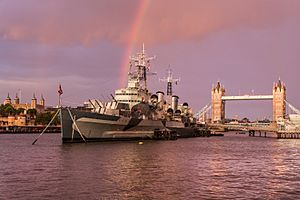
After her retirement, Belfast was at risk of being scrapped. However, many people believed she was too important to lose. The Imperial War Museum and others worked together to save her. In 1971, the government decided against preserving her, but a private group, the HMS Belfast Trust, stepped in.
The Trust successfully campaigned to save the ship. In July 1971, the government handed Belfast over to the Trust. She was towed from Portsmouth to London and prepared as a museum. On October 15, 1971, she was moved to her permanent home near Tower Bridge on the River Thames.
Belfast opened to the public on October 21, 1971. This date was special because it was Trafalgar Day, marking a famous naval victory. Belfast was the first naval ship saved for the nation since Lord Nelson's flagship, HMS Victory. She was even allowed to continue flying the White Ensign, the flag of the Royal Navy.
In 1978, the HMS Belfast Trust merged with the Imperial War Museum. Belfast became the museum's third branch. Today, she is a very popular tourist attraction.
Keeping Belfast Shipshape
To keep Belfast in good condition, she has been taken to drydock twice since becoming a museum. In 1999, she was towed to Portsmouth for cleaning and repainting. Her hull was painted in a special camouflage pattern she wore during World War II.
In 2010, new masts were made for Belfast in Russia. These replaced the old, corroded ones. The new masts were dedicated in a ceremony attended by Prince Philip and veterans.
In 2017, the Royal Navy announced that a new warship would also be named Belfast. To avoid confusion, the museum ship is now officially called "HMS Belfast (1938)".
Exploring the Ship: What You Can See
Visitors to HMS Belfast can explore nine different decks. You can walk through areas that show what life was like for the crew. See the sick bay, the kitchen (galley), the laundry, and the sleeping areas (mess decks). School groups can even stay overnight on board, sleeping in bunks.
You can also go below the waterline to see the ship's inner workings. Explore the engine and boiler rooms, and the control room for the ship's guns. On the upper deck, you can see the big guns, the command center, and the Admiral's bridge.
One of the 6-inch gun turrets has special effects to show what it was like during the Battle of North Cape. The forward 6-inch guns are aimed at a spot 12 miles (19 km) away to show their range. Belfast also hosts the City of London Sea Cadet Corps.
In 2011, a small accident happened when a gangway collapsed during renovations. The ship was closed for a while but reopened in May 2012. A new building with a café and shop was also built on the riverbank.
See also
 In Spanish: HMS Belfast (C35) para niños
In Spanish: HMS Belfast (C35) para niños


